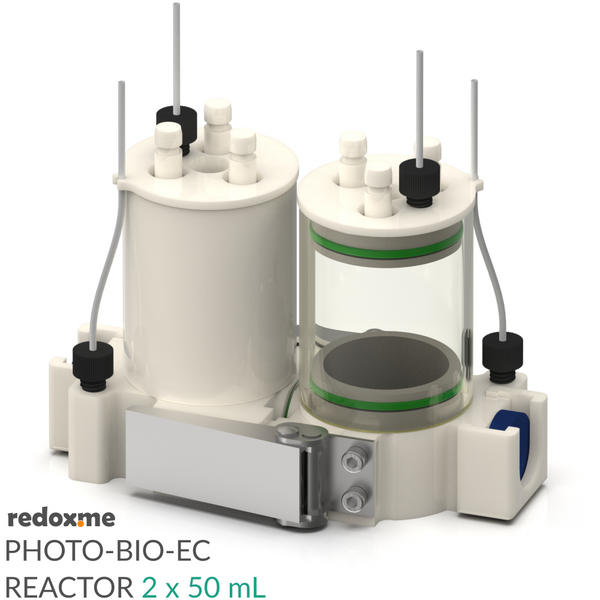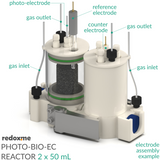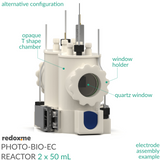Photo-Bio-EC Reactor - Photo-bioelectrochemical reactor 2 x 50 mL

This photo-bioelectrochemical (microbial) reactor is used to generate electricity upon irradiation of biomaterial-functionalized electrodes in aqueous solutions. In a classical photolysis experiment the solar Illumination of the photoanode yields the oxidation of water to O2 and the transfer of electrons through the external circuit to the cathode, where O2 is re-reduced to water. This setup may operate as one H-Cell (two chamber system with a membrane in between electrodes) or as two separated single chamber systems when using the chamber end caps (not included in the set). The H-cell configuration also offers the possibility to run the device as a microbial electrolysis cell, where hydrogen gas is produced at the cathode.
The current collectors for (photo-)bioanode and/or (photo-)biocathode as well and standard metal- or carbon-based anodes and cathodes, are available for that cell. A convenient way to install (photo-)electrodes can be realized using Tantalum wire clips.
Various chamber types are available for that cell. A default configuration contains one quartz chamber (tube) and one opaque chamber. Other chambers are available on request.
When choosing an artificial light source for this setup one needs to consider the absorption maxima of the photo-electrode. Because light is a necessity in photo-bioelectrochemical studies, care must be taken on possible abiotic side effects of illumination. This includes warming up of the setup due to intense illumination. To optimize the irradiation of the system and be able to adjust the intensity (too high light intensities will lower the efficiency) redox.me recommends two light sources: 1) LED Solar Simulator class AAA and 2) Switchable LED light source. A light intensity power meter (available on request) is also a useful tool when arranging the setup.
The cell elements are constructed with material that is inert to the studied biomaterial system (bio-compatible thermosetting resin highly loaded with glass beads). It well fits aqueous (FKM O-Rings) electrolyte requirements in a full pH spectrum. The construction is liquid- and gas-tight. Various membrane materials and thicknesses are compatible with this cell including nanoporous and ion-exchange membranes.
Application note
The list of applications includes, but is not limited to microbial fuel cell, microbial electrolysis cell, microbial electrosynthesis (fuel and chemical production), microbial desalination cell, enzymatic biofuel cell and all the above variants with light irradiation (light supported) as well as microbial solar cell. Typically, microbes such as microalgae, electrogenic microalgae and photosynthetic bacteria are used to functionalize electrodes.
Specification
maximum volume: 2 x 50 mL
membrane aperture: 1 cm2 (11.3 mm dia.)
recommended membrane diameter: 25 mm
electrode plug diameter: 6 mm
stopper diameter: 14 mm
Intrastat data
HS Code: 90309000
Country of Origin: Sweden
NET weight: 300g
Product includes
1 x cell base with adjustable hook clamps
1 x cell base
2 x lid
1 x quartz chamber
1 x opaque chamber
6 x plug
2 x rubber septum stopper
2 x septum lock
Related products
Chambers for Photo-Bio-EC Reactor - 50 mL
Chamber End Caps for Photo-Bio-EC Reactor - 50 mL
metal based current collectors
metal based electrodes
carbon based and metal oxide electrodes and current collectors
reference electrodes
membranes
Graphite ink for carbon interlayer






















